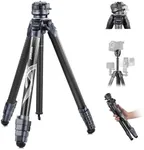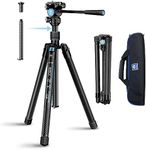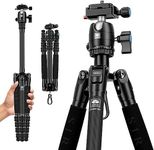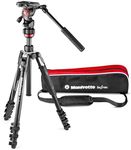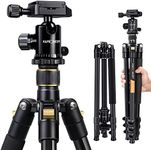Buying Guide for the Best Travel Tripods
Choosing the right travel tripod is all about balancing portability, stability, and ease of use. Since travel tripods are designed to be lightweight and compact, it's important to consider how you'll be using it—whether for hiking, city trips, or casual vacations. Think about the type of camera you use, how much gear you typically carry, and the environments you'll be shooting in. The best travel tripod for you will be one that fits comfortably in your bag, supports your camera securely, and is quick to set up and pack away.WeightWeight refers to how heavy the tripod is when fully packed. This is important because you'll be carrying it along with your other gear, sometimes for long periods. Travel tripods generally range from very lightweight (under 1 kg) to moderately heavy (up to 2 kg). Lighter tripods are easier to carry but may be less stable, while heavier ones offer more stability but can be tiring to transport. If you plan to hike or walk a lot, go for a lighter model. If you mostly travel by car or need extra stability for heavier cameras, a slightly heavier tripod might be better.
Folded LengthFolded length is the size of the tripod when it's collapsed and ready to pack. This matters because it determines whether the tripod will fit in your backpack or luggage. Folded lengths can range from about 30 cm (very compact) to over 50 cm (less portable). If you want a tripod that fits inside most bags, look for a shorter folded length. If you don't mind strapping it to the outside of your bag or have more space, a longer folded length can be acceptable.
Maximum HeightMaximum height is how tall the tripod stands when fully extended. This is important for comfortable shooting, especially if you prefer not to bend over. Travel tripods usually offer maximum heights from around 100 cm (shorter, more compact) to 160 cm or more (taller, but often bulkier). If you want to shoot at eye level, look for a tripod that matches your height. If you’re okay with lower angles or want to save space, a shorter tripod will do.
Load CapacityLoad capacity tells you how much weight the tripod can safely support. This is crucial for making sure your camera and lens are stable and secure. Travel tripods typically support between 3 kg (for small cameras) and 10 kg or more (for larger DSLRs or telephoto lenses). If you use a lightweight mirrorless or compact camera, a lower load capacity is fine. For heavier cameras or long lenses, choose a tripod with a higher load capacity.
MaterialTripods are usually made from aluminum or carbon fiber. Aluminum tripods are generally more affordable and slightly heavier, while carbon fiber tripods are lighter and more resistant to vibration but cost more. If you want the lightest possible setup and don’t mind paying extra, carbon fiber is a good choice. If weight isn’t your top concern, aluminum offers good value and durability.
Leg LocksLeg locks are the mechanisms that let you extend and secure the tripod legs. There are two main types: twist locks and flip locks. Twist locks are quieter and often more compact, while flip locks are quicker and easier to use, especially with gloves. If you value speed and convenience, flip locks might suit you. If you prefer a sleeker design and don’t mind taking a bit more time, twist locks are a good option.
Center ColumnThe center column is the part that lets you raise the camera higher without extending the legs. Some tripods have a removable or reversible center column for low-angle shots. A center column adds flexibility but can reduce stability when fully extended. If you often shoot from low angles or want maximum stability, look for a tripod with a removable or short center column. If you need extra height occasionally, a standard center column is useful.
Head TypeThe tripod head is where you attach your camera, and it controls how you move and position it. Common types are ball heads (quick and versatile) and pan-tilt heads (precise control for video or panoramas). Ball heads are compact and easy to use, making them popular for travel. Pan-tilt heads are bulkier but offer more control. Choose a head type based on how you like to shoot—if you want speed and simplicity, go for a ball head; if you need precise adjustments, consider a pan-tilt head.

